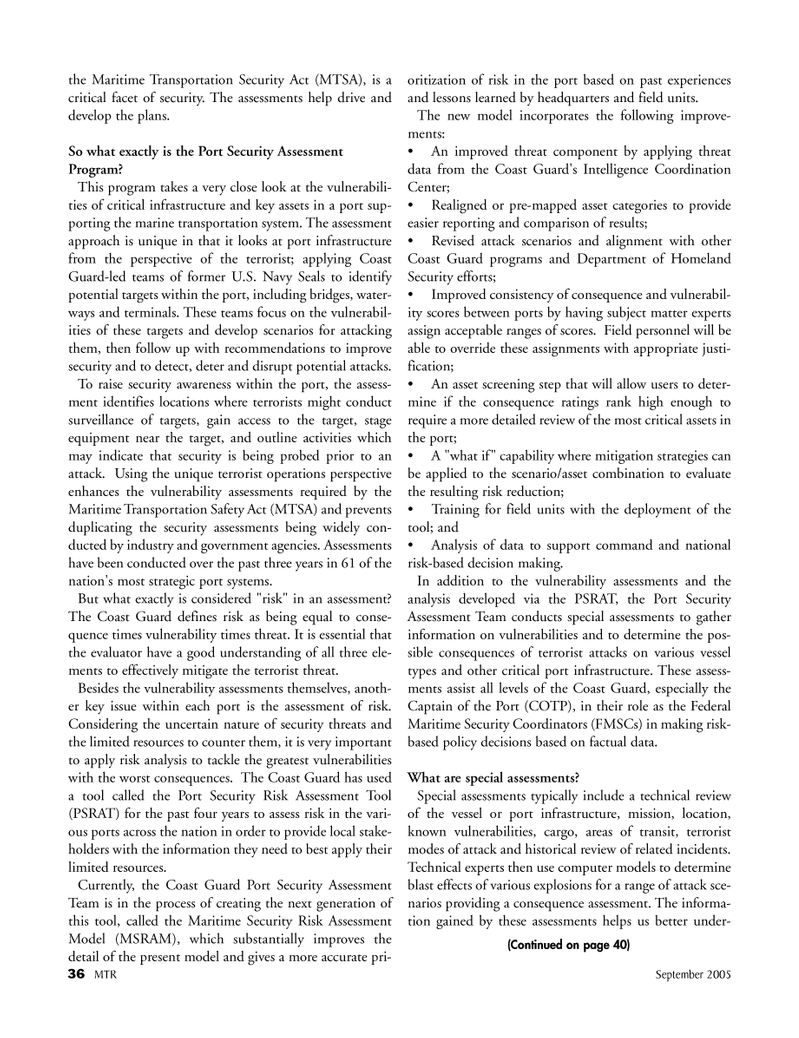
Page 36: of Marine Technology Magazine (September 2005)
Maritime Security & Undersea Defense
Read this page in Pdf, Flash or Html5 edition of September 2005 Marine Technology Magazine
36 MTR September 2005 the Maritime Transportation Security Act (MTSA), is a critical facet of security. The assessments help drive and develop the plans.
So what exactly is the Port Security Assessment
Program?
This program takes a very close look at the vulnerabili- ties of critical infrastructure and key assets in a port sup- porting the marine transportation system. The assessment approach is unique in that it looks at port infrastructure from the perspective of the terrorist; applying Coast
Guard-led teams of former U.S. Navy Seals to identify potential targets within the port, including bridges, water- ways and terminals. These teams focus on the vulnerabil- ities of these targets and develop scenarios for attacking them, then follow up with recommendations to improve security and to detect, deter and disrupt potential attacks.
To raise security awareness within the port, the assess- ment identifies locations where terrorists might conduct surveillance of targets, gain access to the target, stage equipment near the target, and outline activities which may indicate that security is being probed prior to an attack. Using the unique terrorist operations perspective enhances the vulnerability assessments required by the
Maritime Transportation Safety Act (MTSA) and prevents duplicating the security assessments being widely con- ducted by industry and government agencies. Assessments have been conducted over the past three years in 61 of the nation's most strategic port systems.
But what exactly is considered "risk" in an assessment?
The Coast Guard defines risk as being equal to conse- quence times vulnerability times threat. It is essential that the evaluator have a good understanding of all three ele- ments to effectively mitigate the terrorist threat.
Besides the vulnerability assessments themselves, anoth- er key issue within each port is the assessment of risk.
Considering the uncertain nature of security threats and the limited resources to counter them, it is very important to apply risk analysis to tackle the greatest vulnerabilities with the worst consequences. The Coast Guard has used a tool called the Port Security Risk Assessment Tool (PSRAT) for the past four years to assess risk in the vari- ous ports across the nation in order to provide local stake- holders with the information they need to best apply their limited resources.
Currently, the Coast Guard Port Security Assessment
Team is in the process of creating the next generation of this tool, called the Maritime Security Risk Assessment
Model (MSRAM), which substantially improves the detail of the present model and gives a more accurate pri- oritization of risk in the port based on past experiences and lessons learned by headquarters and field units.
The new model incorporates the following improve- ments: • An improved threat component by applying threat data from the Coast Guard's Intelligence Coordination
Center; Realigned or pre-mapped asset categories to provide easier reporting and comparison of results; Revised attack scenarios and alignment with other
Coast Guard programs and Department of Homeland
Security efforts; Improved consistency of consequence and vulnerabil- ity scores between ports by having subject matter experts assign acceptable ranges of scores. Field personnel will be able to override these assignments with appropriate justi- fication; An asset screening step that will allow users to deter- mine if the consequence ratings rank high enough to require a more detailed review of the most critical assets in the port; A "what if" capability where mitigation strategies can be applied to the scenario/asset combination to evaluate the resulting risk reduction; Training for field units with the deployment of the tool; and Analysis of data to support command and national risk-based decision making.
In addition to the vulnerability assessments and the analysis developed via the PSRAT, the Port Security
Assessment Team conducts special assessments to gather information on vulnerabilities and to determine the pos- sible consequences of terrorist attacks on various vessel types and other critical port infrastructure. These assess- ments assist all levels of the Coast Guard, especially the
Captain of the Port (COTP), in their role as the Federal
Maritime Security Coordinators (FMSCs) in making risk- based policy decisions based on factual data.
What are special assessments?
Special assessments typically include a technical review of the vessel or port infrastructure, mission, location, known vulnerabilities, cargo, areas of transit, terrorist modes of attack and historical review of related incidents.
Technical experts then use computer models to determine blast effects of various explosions for a range of attack sce- narios providing a consequence assessment. The informa- tion gained by these assessments helps us better under- (Continued on page 40)
MTR#2 (33-48).qxd 8/30/2005 5:26 PM Page 36

 35
35

 37
37
